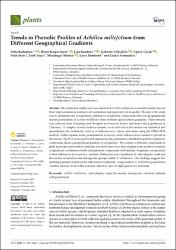| dc.contributor.author | Radusiene, Jolita | |
| dc.contributor.author | Karpaviciene, Birute | |
| dc.contributor.author | Raudone, Lina | |
| dc.contributor.author | Vilkickyte, Gabriele | |
| dc.contributor.author | Çırak, Cüneyt | |
| dc.contributor.author | Seyis, Fatih | |
| dc.contributor.author | Yayla, Fatih | |
| dc.contributor.author | Marksa, Mindaugas | |
| dc.contributor.author | Rimkiene, Laura | |
| dc.contributor.author | Ivanauskas, Liudas | |
| dc.date.accessioned | 2023-09-06T07:34:41Z | |
| dc.date.available | 2023-09-06T07:34:41Z | |
| dc.date.issued | 2023 | en_US |
| dc.identifier.citation | Radušienė, J., Karpavičienė, B., Raudone, L., Vilkickyte, G., Çırak, C., Seyis, F., Yayla, F., Marksa, M., Rimkienė, L., & Ivanauskas, L. (2023). Trends in Phenolic Profiles of Achillea millefolium from Different Geographical Gradients. Plants (Basel, Switzerland), 12(4), 746. https://doi.org/10.3390/plants12040746 | en_US |
| dc.identifier.issn | 2223-7747 | |
| dc.identifier.uri | https://doi.org/10.3390/plants12040746 | |
| dc.identifier.uri | https://hdl.handle.net/11436/8268 | |
| dc.description.abstract | The traditional widely used raw material of Achillea millefolium is currently mainly derived from wild populations, leading to diversification and uncertainty in its quality. The aim of the study was to determine the accumulation differences of phenolic compounds between geographically distant populations of Achillea millefolium from northern and southern gradients. Plant material was collected from Gaziantep and Nevsehir provinces in Turkey and from wild populations in Lithuania. A complex of nine hydroxycinnamic acids and eleven flavonoids was identified and quantified in the methanolic extracts of inflorescences, leaves, and stems using the HPLC-PDA method. Caffeoylquinic acids predominated in leaves, while inflorescences tended to prevail in flavonoids. The PCA score plot model represented the quantitative distribution pattern of phenolic compounds along a geographical gradient of populations. The content of phenolic compounds in plant materials from northern latitudes was more than twice that of plants from southern latitudes. A significant correlation of individual phenolic compounds with latitude/longitude corresponded to their differences between two countries. Differences in accumulation of caffeoylquinic acids and flavonoids revealed several intraspecific groups within A. millefolium. Our findings suggest that spatial geographical data on the distribution of phenolic compounds in A. millefolium populations could be used as a tool to find potential collection sites for high-quality raw materials. | en_US |
| dc.language.iso | ara | en_US |
| dc.publisher | MDPI | en_US |
| dc.rights | info:eu-repo/semantics/openAccess | en_US |
| dc.subject | Achillea millefolium | en_US |
| dc.subject | Caffeoylquinic acids | en_US |
| dc.subject | Flavonoids | en_US |
| dc.subject | Intraspecific variation | en_US |
| dc.subject | Latitude | en_US |
| dc.subject | Wild populations | en_US |
| dc.title | Trends in phenolic profiles of achillea millefolium from different geographical gradients | en_US |
| dc.type | article | en_US |
| dc.contributor.department | RTEÜ, Ziraat Fakültesi, Bahçe Bitkileri Bölümü | en_US |
| dc.contributor.institutionauthor | Seyis, Fatih | |
| dc.identifier.doi | 10.3390/plants12040746 | en_US |
| dc.identifier.volume | 12 | en_US |
| dc.identifier.issue | 4 | en_US |
| dc.identifier.startpage | 746 | en_US |
| dc.relation.journal | Plants-Basel | en_US |
| dc.relation.publicationcategory | Makale - Uluslararası Hakemli Dergi - Kurum Öğretim Elemanı | en_US |


















